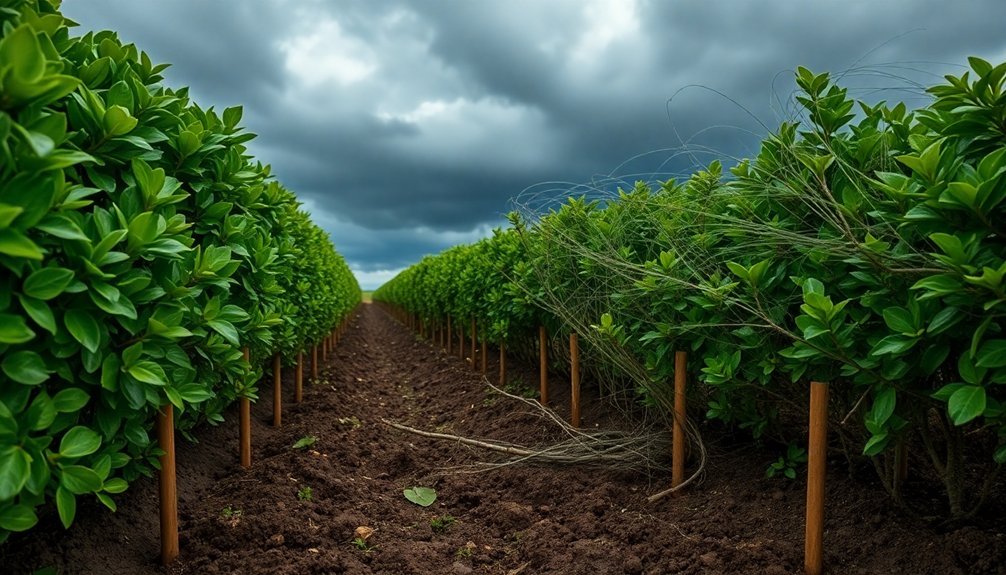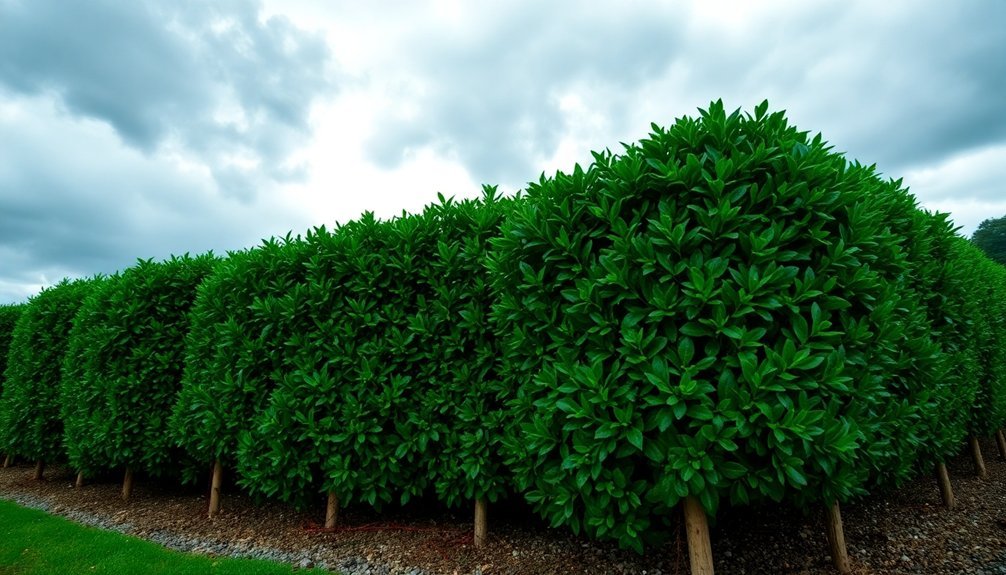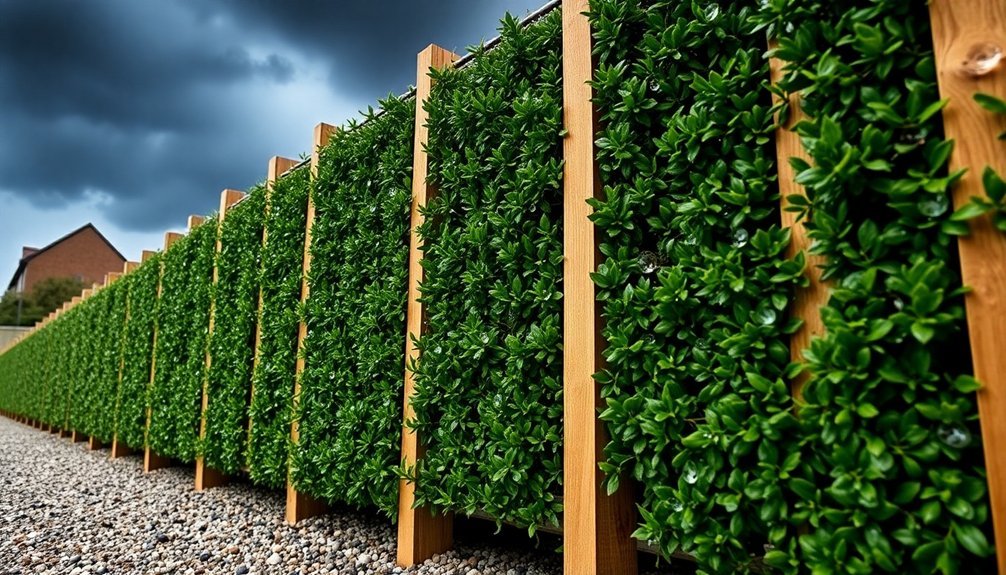To create storm-proof hedges, you'll need proper foundation assessment, quality materials, and strategic anchoring. Choose polyethylene hedges with UV protection mounted on powder-coated stainless steel frames. Install deeper foundations in unstable soil and use staking support with flexible cable systems. Double-secure edge panels with additional fasteners and conduct regular inspections. Proper seasonal maintenance including pruning and reinforcement will greatly increase your hedge's resistance against even the most severe weather conditions.
Assessing Your Fence Foundation for Maximum Storm Resilience

When building storm-resistant hedges, your fence foundation serves as the essential first line of defense against nature's fury.
You'll need to evaluate your soil type carefully, as clay or sandy compositions often require additional reinforcement to prevent shifting during storms.
Consider conducting a geotechnical survey to understand what's beneath the surface. This data helps you determine appropriate footing depth and anchoring methods.
Knowledge is power when it comes to fence foundations. Geotechnical surveys reveal what you can't see but must absolutely plan for.
Installing deeper foundations in unstable soil provides vital support when high winds and heavy rains threaten your property.
Don't overlook drainage patterns around your fence line. Poor water management can quickly erode soil surrounding posts, compromising structural integrity.
Regular soil assessments before storm seasons will help you identify potential vulnerabilities and address them before they become costly failures.
Adapting your installation approach based on continuous research allows you to incorporate the latest storm-resistant techniques as weather patterns evolve.
Material Selection for Weather-Resistant Artificial Hedges
Selecting the right materials for your artificial hedges stands as the cornerstone of creating a truly storm-resistant barrier. For maximum weather resilience, choose polyethylene (PE) hedges as they offer superior UV protection compared to plastic or silk alternatives. PE withstands harsh elements while maintaining vibrant color for 5-10 years.
Pair your foliage with powder-coated stainless steel frames that resist rust and corrosion. These frames distribute weight evenly, providing essential stability during high winds. Confirm UV protection is integrated into the material rather than applied as a coating for lasting durability. Artigwall's products feature commercial-grade materials specifically engineered to endure various weather conditions for several years without degradation.
For areas prone to fire hazards, select hedges treated with fire-retardant coatings.
Remember that non-toxic materials aren't just environmentally responsible—they're also safer for your family and pets while naturally deterring pests.
Strategic Anchoring Techniques for Heavy Wind Conditions

Properly anchoring your artificial hedges determines whether they'll stand tall during fierce storms or become dangerous projectiles. Implement a multi-layered approach by combining staking support with flexible cable systems for maximum stability.
Install temporary stakes or trellises to stabilize newly planted hedges, particularly for taller varieties. For established hedges, consider guying systems with anchored cables that allow natural movement while preventing excessive swaying. Regularly monitoring your anchors ensures they can be adjusted as needed to accommodate the growth of your hedges and prevent potential damage.
Don't overlook your hedge's foundation—strengthen root systems through proper drainage and consistent watering practices. Add temporary windbreaks during storm seasons for additional protection.
For thorough protection, integrate your hedges with complementary elements like low fencing or strategically placed planters. These create additional wind barriers while enhancing the aesthetic appeal of your landscape design.
Surface-Specific Installation Methods for Different Fence Types
Different surfaces present unique challenges when installing hedges alongside various fence types, demanding tailored approaches for ideal stability and longevity.
On steep slopes, use stepped fencing to maintain structural integrity while guaranteeing your hedge receives proper drainage. For clay soils, raise plants slightly to prevent waterlogging around roots.
Adapt to challenging terrains by elevating plants in dense clay or using stepped fencing on slopes for optimal drainage.
When dealing with hard surfaces like concrete patios, opt for surface-mounted fence posts with secure anchoring systems, then integrate your hedging within these lines for enhanced privacy without blocking views.
In sandy conditions, supplement your soil with organic matter to improve water retention for your hedge plants. Loose soil requires deeper post installations—similar to hurricane-prone area techniques—while trench planting alongside these reinforced structures ensures even spacing and uniform hedge development. Before starting your trench, always check for utility lines to avoid damaging underground infrastructure during the installation process.
Reinforcement Strategies to Prevent Wind Lift and Damage

When installing storm-proof hedges, you'll need to double-secure edge panels with additional fasteners at perimeter points where wind can catch and lift your barriers.
Strategic tie placement at both high-stress junctions and midpoints will distribute force evenly across the hedge structure during severe weather.
Implementing proper weight distribution techniques, such as installing heavier base materials or graduated density patterns, will greatly increase your hedge's resistance to wind uplift and prevent catastrophic failure during storms. Regular maintenance checks will help identify vulnerabilities in your hedge barriers before severe weather events occur.
Double-Secure Edge Panels
The four most critical elements of double-secure edge panels create a thorough defense system against storm damage.
First, ascertain your panels overlap slightly to eliminate gaps where wind could penetrate and create lift.
Second, use SS304 stainless steel hardware and high-strength fasteners to maintain panel integrity during fierce winds.
Third, implement a double lock mechanism that prevents panels from dislodging even when battered by hurricane-force gusts.
These specialized locks work in tandem with gasket seals, which form the fourth element of your protection strategy.
These seals not only enhance airtightness between panel connections but also prevent moisture intrusion that could compromise structural integrity over time.
Similar to how financial traders maintain delta neutrality daily, your installation should be checked regularly to ensure all protective elements remain properly aligned and functional.
Don't forget to seal all edges thoroughly—this seemingly small detail makes a significant difference in your hedge's storm resistance capability.
Strategic Tie Placement
Proper strategic tie placement serves as your hedge's first line of defense against devastating wind damage and structural failure during severe storms. You'll need to secure your hedges with appropriate ties that provide stability while allowing natural movement.
| Tie Type | Placement | Purpose |
|---|---|---|
| Flexible fabric | Upper third | Prevents top-heavy sway while allowing movement |
| Stake anchors | Base of plants | Stabilizes root system during high winds |
| Cross supports | Middle section | Distributes wind force across hedge structure |
Install ties in a figure-eight pattern to avoid bark damage and chafing. For taller hedges, place supports every 18-24 inches along the length. During storm season, check ties monthly and adjust as needed to accommodate growth. Remember that overly tight bindings can restrict growth and damage stems, while loose ties won't provide adequate protection. The natural flexibility of hedges can be maintained while providing necessary support when ties are installed correctly.
Weight Distribution Techniques
Balanced weight distribution throughout your hedge forms the cornerstone of lasting storm resilience, protecting your investment from catastrophic wind damage. To achieve this, incorporate deep-rooted vegetation like switchgrass that enhances soil cohesion and stability against powerful winds.
Design your hedge with proper spacing to prevent crowding while ensuring it's wide enough to develop substantial root mass. Unlike solid barriers, hedges should allow some air to pass through, reducing dangerous turbulence that can uproot plants. Installing strong support posts sunk at least 2 feet into the ground provides crucial stability during high winds.
Consider your soil type carefully—silty soils require different approaches due to their specific friction angles and cohesion properties. For steeper banks, implement more robust stabilization techniques and monitor soil conditions regularly.
When necessary, integrate external anchoring systems in extreme wind-prone areas to provide additional reinforcement against lifting forces.
Weather Sealing Your Hedge Panels for Longevity

Effective weather sealing can extend your artificial hedge panels' lifespan by up to three times in harsh outdoor environments.
Apply UV protection sprays to prevent fading and cracking, especially if your property receives intense sunlight. This simple step reinforces the built-in UV resistance of high-quality panels.
For WPC panels, guarantee proper alignment during installation to prevent water infiltration.
Use expansion screws or staple guns to secure panels firmly against walls, creating a weather-tight seal that can withstand strong winds.
Don't overlook drainage considerations—proper water flow prevents moisture accumulation that could compromise longevity. Regularly clean your hedges to remove dust and debris that can accelerate deterioration when combined with harsh weather elements.
Remember that while high-quality panels can last 25-50 years, proper weather sealing is essential to reach the upper end of this range, making your initial investment markedly more cost-effective.
Maintenance and Inspection Routines for Storm-Season Preparedness
Regular inspections of your storm-proof hedges should occur monthly during calm weather and weekly as storm season approaches.
You'll need to check for loose panels, root stability, and structural integrity while reinforcing vulnerable sections with additional supports.
Seasonal reinforcement techniques include strategic pruning to reduce wind resistance, applying stabilizing mulch around the base, and securing any detached components with weather-resistant fasteners. Maintaining thick, dense hedges helps protect homes from damaging winds during storms.
Regular Inspection Schedule
A well-structured inspection schedule forms the backbone of storm-proof hedge maintenance. You'll need to establish a consistent routine that adapts to both seasonal changes and unexpected weather events. Documentation of findings is necessary for accountability in your hedge inspection process.
| Inspection Type | Recommended Frequency |
|---|---|
| Visual Assessment | Weekly during storm season |
| Root Stability Check | Monthly |
| Structural Integrity | Quarterly |
| Pre-Storm Inspection | 24-48 hours before forecast storms |
| Post-Storm Assessment | Within 48 hours after event |
Document all findings using digital tools to track changes over time. Don't neglect community engagement—residents can alert you to issues between scheduled inspections. When conducting assessments, pay special attention to soil conditions around root systems, as saturated ground considerably impacts hedge stability during high winds. Mark vulnerable sections with weatherproof signage to guarantee they're prioritized during maintenance visits.
Seasonal Reinforcement Techniques
Transforming your hedge from merely decorative to genuinely storm-resistant requires strategic seasonal maintenance that anticipates weather challenges.
Prioritize late winter pruning to eliminate weak branches before spring growth begins, using clean, sharp tools to prevent disease spread.
Apply balanced fertilizers in early spring and late summer, with an additional autumn application for evergreens. This timing strengthens your hedge's structure precisely when it needs resilience most. Choose slow-release formulations that provide prolonged nutrient supply during extreme weather conditions.
For maximum storm protection:
- Mulch heavily before dry or windy seasons to maintain moisture and protect root systems
- Inspect for and repair any structural gaps quarterly, especially before storm season arrives
- Consider planting sturdy native species like Blackthorn in vulnerable sections to reinforce your existing hedge barrier
Frequently Asked Questions
Can Artificial Hedges Withstand Hurricane-Force Winds?
No, your artificial hedges can't withstand hurricane-force winds alone. They're lightweight and will likely tear or blow away. You'll need specialized anchoring systems if you want them to survive extreme weather conditions.
How Do Different Climate Zones Affect Installation Requirements?
In different climate zones, you'll need to adjust your installation depth, spacing, drainage solutions, and anchoring methods. You should also select zone-appropriate plants and adapt your soil amendments to local precipitation patterns.
Are There Eco-Friendly Artificial Hedge Options Available?
Yes, you'll find many eco-friendly artificial hedge options made from recyclable PE materials. They're UV-protected, require no water or chemicals, and their durability means less frequent replacement, reducing your environmental footprint long-term.
Can Storm-Proof Hedges Provide Noise Reduction Benefits?
Yes, your storm-proof hedges will provide excellent noise reduction benefits. Their dense foliage absorbs sound waves, especially when you've chosen thick evergreen varieties and maintained them with regular pruning for ideal density.
What's the Average Lifespan of Properly Installed Storm-Resistant Hedges?
Your storm-resistant hedges can last 30-40 years with regular maintenance, while tree-based options like cedar may survive 100+ years. You'll get maximum lifespan when you combine proper installation with ongoing care and pruning.
In Summary
You've now got all the knowledge to create truly storm-resistant artificial hedges. Remember, your foundation assessment, material selection, and proper anchoring are your first line of defense. Don't skip the reinforcement strategies or weather sealing steps. By following these installation techniques and maintaining regular inspections, you'll enjoy beautiful, durable hedges that stand strong against whatever mother nature throws their way.





Leave a Reply